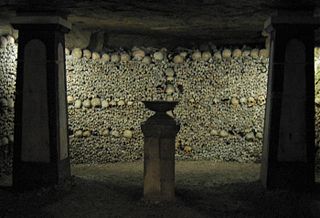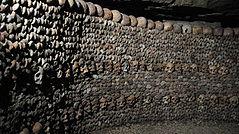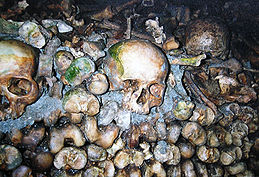
Catacombs of Paris
Encyclopedia

Ossuary
An ossuary is a chest, building, well, or site made to serve as the final resting place of human skeletal remains. They are frequently used where burial space is scarce. A body is first buried in a temporary grave, then after some years the skeletal remains are removed and placed in an ossuary...
in Paris
Paris
Paris is the capital and largest city in France, situated on the river Seine, in northern France, at the heart of the Île-de-France region...
, France
France
The French Republic , The French Republic , The French Republic , (commonly known as France , is a unitary semi-presidential republic in Western Europe with several overseas territories and islands located on other continents and in the Indian, Pacific, and Atlantic oceans. Metropolitan France...
. Located south of the former city gate (the "Barrière d'Enfer" at today's Place Denfert-Rochereau
Place Denfert-Rochereau
Place Denfert-Rochereau, previously known as Place d'Enfer, is a public square located in the 14th arrondissement of Paris, France, in the Montparnasse district, at the intersection of the boulevards Raspail, Arago, and Saint-Jacques, and the avenues René Coty, Général Leclerc, and , as well as the...
), the ossuary holds the remains of about 6 million people and fills a renovated section of caverns and tunnels that are the remains of Paris' stone mines
Mines of Paris
The Mines of Paris comprise a number of abandoned, subterranean mines under Paris, France, connected together by galleries...
. Opened in the late 18th century, the underground cemetery became a tourist attraction on a small scale from the early 19th century, and has been open to the public on a regular basis from 1867. Following an incident of vandalism, they were closed to the public in September 2009 and reopened 19 December of the same year.
The official name for the catacombs is l'Ossuaire Municipal. Although this cemetery covers only a small section of underground tunnels comprising "les carrières de Paris
Mines of Paris
The Mines of Paris comprise a number of abandoned, subterranean mines under Paris, France, connected together by galleries...
" ("the quarries of Paris"), Parisians today often refer to the entire tunnel network as "the catacombs".
Background: Parisian cemeteries

Les Halles
Les Halles is an area of Paris, France, located in the 1er arrondissement, just south of the fashionable rue Montorgueil. It is named for the large central wholesale marketplace, which was demolished in 1971, to be replaced with an underground modern shopping precinct, the Forum des Halles...
district, this cemetery had its own Saints Innocents
Saints Innocents Cemetery
The Saints Innocents Cemetery is a defunct cemetery in Paris that was used from the Middle Ages until the late 18th century. It was the oldest and largest cemetery in Paris and had often been used for mass graves...
church and parish apellation by the end of the same century. Eventually Paris' other churches adopted the technique of mass inhumation as well. Once an excavation in one section of the cemetery was full, it would be covered over and another opened. Residues resulting from the decaying of organic matter, a process often chemically accelerated with the use of lime, entered directly into the earth, creating a situation quite unacceptable for a city whose then principal source of liquid sustenance was well water.
By the 17th century the sanitary conditions around Saints Innocents were unbearable. As it was one of Paris' most sought-after cemeteries and a large source of revenue for the parish and church, the clergy had continued burials there even when its grounds were filled to overflowing. By then the cemetery was lined on all four sides with "charniers" reserved for the bones of the dead exhumed from mass graves that had "lain" long enough for all the flesh they contained to decompose. Once emptied, a mass sepulchre would be used again, but even then the earth was already filled beyond saturation with decomposing human remains.
A series of ineffective decrees limiting the use of the cemetery did little to remedy the situation, and it wasn't until the late 18th century that it was decided to create three new large-scale suburban burial grounds on the outskirts of the city, and to condemn all existing parish cemeteries within city limits.
The new cemeteries were created outside the central area of the capital, in the early 19th century: Montmartre Cemetery
Montmartre Cemetery
Montmartre Cemetery is a cemetery in the 18th arrondissement of Paris, France.-History:Cemeteries had been banned from Paris since the shutting down of the Cimetière des Innocents in 1786, as they presented health hazards...
in the north, Père Lachaise Cemetery
Père Lachaise Cemetery
Père Lachaise Cemetery is the largest cemetery in the city of Paris, France , though there are larger cemeteries in the city's suburbs.Père Lachaise is in the 20th arrondissement, and is reputed to be the world's most-visited cemetery, attracting hundreds of thousands of visitors annually to the...
in the east, Passy Cemetery
Passy Cemetery
The Passy Cemetery is a famous cemetery located at 2, rue du Commandant Schlœsing in Passy, in the 16th arrondissement of Paris, France.-History:...
in the west. Later, Montparnasse Cemetery
Montparnasse Cemetery
Montparnasse Cemetery is a cemetery in the Montparnasse quarter of Paris, part of the city's 14th arrondissement.-History:Created from three farms in 1824, the cemetery at Montparnasse was originally known as Le Cimetière du Sud. Cemeteries had been banned from Paris since the closure, owing to...
was added in the south.
Paris' former mines
Part of the reason nothing was done about Paris's untenable burial practices was a lack of ideas for disposing of the dead exhumed from the city's intra-muros parish graveyards. The government had been searching for and consolidating long abandoned stone quarries in and around the capital since 1777, and it was the Police Lieutenant General overseeing the renovations, Alexandre LenoirAlexandre Lenoir
Marie Alexandre Lenoir was a French archaeologist. Self-taught and devoted to saving France's historic monuments, sculptures and tombs from the ravages of the French Revolution, notably those of Saint-Denis and Sainte-Geneviève.- Life :The ravages of the Revolution caused the birth of the Musée...
, who first had the idea to use empty underground tunnels on the outskirts of the capital to this end. His successor, Thiroux de Crosne, chose a place to the south of Paris' "porte d'Enfer" city gate (the place Denfert-Rochereau
Place Denfert-Rochereau
Place Denfert-Rochereau, previously known as Place d'Enfer, is a public square located in the 14th arrondissement of Paris, France, in the Montparnasse district, at the intersection of the boulevards Raspail, Arago, and Saint-Jacques, and the avenues René Coty, Général Leclerc, and , as well as the...
today), and the exhumation and transfer of all Paris' dead to the underground sepulture began in 1786, taking until 1788 to complete.
Creation, decoration
From the eve of a consecration ceremony on the 7th April the same year, behind a procession of chanting priests, began a parade of black-covered bone-laden horse-drawn wagons that continued for years to come. In work overseen by the Inspector General of Quarries, Charles-Axel Guillaumot, the bones were deposited in a wide well dug in land bought from a property, "La maison de la Tombe Issoire" (a house near the bame name), and distributed throughout the underground caverns by workers below. Also deposited near the same house were crosses, urns and other necropolis memorabilia recovered from Paris' church graveyards.
Louis-Étienne Héricart de Thury
Louis-Étienne François Héricart-Ferrand, vicomte de Thury, was a French politician and man of science. He was a mining engineer who produced more than 350 scholarly articles; was a member of numerous societies and professional associations.He was heir to an estate of great horticultural richness...
, oversaw the renovations that would transform the underground caverns into a real and visitable sepulture on par with any mausoleum. In addition to directing the rearrangement of skulls and femurs into the arrangement seen in the catacombs today, he used the tombstones and cemetery decorations he could find (many had disappeared after the 1789 Revolution) to complement the walls of bones.
General description
The Catacombs entry is in the western pavilion of Paris's former Barrière d'Enfer city gate. After descending a narrow spiral stone stairwell of 19 meters to the darkness and silence broken only by the gurgling of a hidden aqueduct channelling local sources away from the area, and after passing through a long (about 1.5 km) and twisting hallway of mortared stone, visitors find themselves before a sculpture that existed from a time before this part of the mines became an ossuary, a model of France's Port-Mahon fortress created by a former Quarry Inspector. Soon after, they would find themselves before a stone portal, the ossuary entry, with the inscription Arrête, c'est ici l'empire de la Mort ('Stop, this is the empire of Death').Beyond begin the halls and caverns of walls of carefully arranged bones. Some of the arrangements are almost artistic in nature, such as a heart-shaped outline in one wall formed with skulls embedded in surrounding tibias; another is a round room whose central pillar is also a carefully created 'keg' bone arrangement. Along the way one would find other 'monuments' created in the years before catacomb renovations, such as a source-gathering fountain baptised "La Samaritaine" because of later-added engravings. There are also rusty gates blocking passages leading to other 'unvisitable' parts of the catacombs – many of these are either un-renovated or were too un-navigable for regular tours.
In a cavern just before the exit stairway leading to a building on the rue Dareau (former 'rue des Catacombes') above, one could see an example of the Quarry Inspection's work in the rest of Paris' underground caverns: its roof is two 11-metre high domes of naturally degraded, but reinforced, rock; the dates painted into the highest point of each bear witness to what year the work to the collapsing cavern ceiling was done, and whether it has degraded since. These "fontis" were the reason for a general panic in late-18th-century Paris, after several houses and roadways collapsed into previously unknown caverns below.
Other inhumations
Bodies of the dead from the riots in the Place de Grève, the Hôtel de Brienne, and Rue Meslée were put in the catacombs on 28 and 29 August 1788.The catacomb walls are covered in graffiti
Graffiti
Graffiti is the name for images or lettering scratched, scrawled, painted or marked in any manner on property....
dating from the eighteenth century onwards. Victor Hugo
Victor Hugo
Victor-Marie Hugo was a Frenchpoet, playwright, novelist, essayist, visual artist, statesman, human rights activist and exponent of the Romantic movement in France....
used his knowledge about the tunnel system in Les Misérables
Les Misérables
Les Misérables , translated variously from the French as The Miserable Ones, The Wretched, The Poor Ones, The Wretched Poor, or The Victims), is an 1862 French novel by author Victor Hugo and is widely considered one of the greatest novels of the nineteenth century...
. In 1871, communards
Paris Commune
The Paris Commune was a government that briefly ruled Paris from March 18 to May 28, 1871. It existed before the split between anarchists and Marxists had taken place, and it is hailed by both groups as the first assumption of power by the working class during the Industrial Revolution...
killed a group of monarchists in one chamber. During World War II
World War II
World War II, or the Second World War , was a global conflict lasting from 1939 to 1945, involving most of the world's nations—including all of the great powers—eventually forming two opposing military alliances: the Allies and the Axis...
, Parisian members of the French Resistance
French Resistance
The French Resistance is the name used to denote the collection of French resistance movements that fought against the Nazi German occupation of France and against the collaborationist Vichy régime during World War II...
used the tunnel system. Also during this period, German soldiers established an underground bunker in the catacombs below Lycée Montaigne
Lycée Montaigne
The Lycée Montaigne is a famous French public secondary school. It is located in the 6th arrondissement of Paris, near the Jardin du Luxembourg, and was founded in the 1880s....
, a high school in the 6th arrondissement.
Books

- In Umberto EcoUmberto EcoUmberto Eco Knight Grand Cross is an Italian semiotician, essayist, philosopher, literary critic, and novelist, best known for his novel The Name of the Rose , an intellectual mystery combining semiotics in fiction, biblical analysis, medieval studies and literary theory...
's novel Foucault's PendulumFoucault's PendulumFoucault's Pendulum is a novel by Italian writer and philosopher Umberto Eco. It was first published in 1988; the translation into English by William Weaver appeared a year later....
, the catacombs were the resting place of a parchment concerning the Knights TemplarKnights TemplarThe Poor Fellow-Soldiers of Christ and of the Temple of Solomon , commonly known as the Knights Templar, the Order of the Temple or simply as Templars, were among the most famous of the Western Christian military orders...
. - In Barbara HamblyBarbara HamblyBarbara Hambly is an award-winning and prolific American novelist and screenwriter within the genres of fantasy, science fiction, mystery, and historical fiction...
's Those Who Hunt the Night, two characters investigating the murders of London vampires descend into the catacombs. There they find Brother Anthony, a 600-year-old priest-turned-vampire, living among the bones of the dead. - In Robison WellsRobison WellsRobison Wells is an American novelist. He currently lives in Provo, Utah, with his wife and three children. He is a member of The Church of Jesus Christ of Latter-day Saints, and his novels are directed to the LDS fiction market...
's novel The Counterfeit, the catacombs are the location of a meeting place of the IlluminatiIlluminatiThe Illuminati is a name given to several groups, both real and fictitious. Historically the name refers to the Bavarian Illuminati, an Enlightenment-era secret society founded on May 1, 1776...
. The main characters, Eric and Rebekah, are guided through the catacombs by three cataphiles. - William T. VollmannWilliam T. VollmannWilliam Tanner Vollmann is an American novelist, journalist, short story writer, essayist and winner of the National Book Award...
's Rising Up and Rising Down: Some Thoughts on Violence, Freedom, and Urgent Means begins with a section titled "Three Medititations on Death". The first meditation, entitled "Catacomb Thoughts", is a reflection on the Catacombs of Paris. - In The 39 CluesThe 39 CluesThe 39 Clues consists of two series of adventure books, The Clue Hunt and Cahills vs. Vespers, combining reading, online gaming, and card collecting...
book 1, "The Maze of BonesThe Maze of BonesThe Maze of Bones was published by Scholastic on September 9, 2008. The story arc of the series has been established by Riordan, but a collaboration of six other authors will continue to write the story through the next nine books.-Plot introduction :...
", the main characters Amy, Dan, and Nellie must search the catacombs in search for a hint to the first clue.
Further reading
- Quigley, Christine (2001) Skulls and skeletons: human bone collections and accumulations. McFarland, Jefferson, NC, USA. pp. 22–29.

